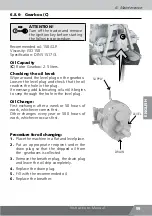
104
Instructions Manual
7. Deactivation
This machine has been developed to offer a long service life, requiring the
recommendations of this manual to be observed and followed. At the end of
the lifespan, it will be necessary to promote the deactivation of the machine,
giving the proper destination to the parts that compose it.
The use of personal protective equipment (safety gloves and goggles) is essential
when handling metal parts and lubricants.
Metal parts (plating,
tubes, bars, cast iron,
etc.)
They should be used for recycling. Scrap ferrous
materials are sold to steelmakers and foundries that
use them as raw material for steel production. We
recall that in the process of recycling metals there is
a considerable reduction in the use of energy and
water, the emission of atmospheric pollutants and
the contamination of the water, which contributes
to the preservation of the environment.
Oils, greases, etc.
They must be removed from the machine and
intended for recycling. Know that used oils are
hazardous waste and have to be properly handled,
stored and intended so that the health of workers
directly linked to their handling and the health of
the population are not harmed. They should not be
dumped on the ground or in waterways to avoid
environmental contamination. Used or contaminated
lubricating oil is a hazardous waste. Do not use it
for any purpose. Return it to your dealer or hand it
over to an authorized dealer.
Plastic parts (chute,
fairings, reservoirs, etc.)
They should be used for recycling. Plastic recycling
is of utmost importance for the environment. When
we recycle the plastic we are contributing to the
environment, because this material leaves to go to
the landfills or the nature, polluting rivers, lakes, soil
and forests.
Tires
They should be used for recycling. Find out about
ways to collect recycling tires in your city or find the
nearest tire dealer. He will receive it and destine it
properly.
Inadequate disposal of tires is a huge environmental
problem. In addition to taking hundreds of years
to decompose, the material exposed to rains
contributes to the silting up of rivers and floods and
becomes ideal for the proliferation of mosquitoes,
such as Aedes aegypti, which transmits diseases such
as dengue, chikungunya and zika.
7.- DEACTIVATION
Summary of Contents for 1600-AT S3
Page 2: ......
Page 3: ...JF 1600 AT S3 COSECHADORA DE PRECISIÓN MULTIFORRAJE ESPAÑOL ...
Page 4: ...ESPAÑOL ...
Page 113: ...Manual de Instrucciones 113 9 Especificaciones ESPAÑOL 9 4 Tabla de medidas de llaves ...
Page 115: ...Manual de Instrucciones 115 9 Especificaciones ESQUEMA HIDRAULICO A B ESPAÑOL ...
Page 118: ...118 Manual de Instrucciones ...
Page 119: ...Manual de Instrucciones 119 ESPAÑOL ...
Page 120: ...120 Manual de Instrucciones ...
Page 121: ...JF 1600 AT S3 MULTI FORAGE PRECISION HARVESTER ENGLISH ENGLISH ...
Page 122: ...ENGLISH ...
Page 230: ...110 Instructions Manual 9 Specifications 9 3 Bolt torque table Torque unit N m ...
Page 231: ...Instructions Manual 111 9 Specifications ENGLISH 9 4 Gauge keys table ...
Page 233: ...Instructions Manual 113 9 Specifications HYDRAULIC SCHEME A B ENGLISH ...
Page 236: ...116 Instructions Manual ...
Page 237: ...Instructions Manual 117 ENGLISH ...
Page 238: ...118 Instructions Manual ...
Page 239: ......
















































